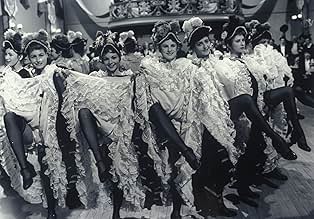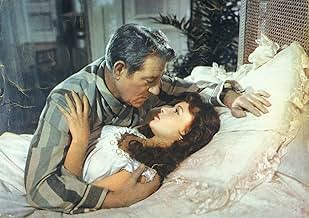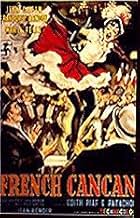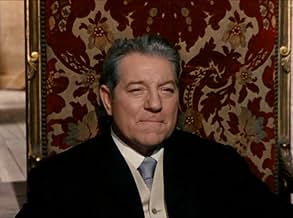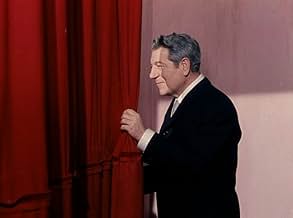ÉVALUATION IMDb
7,3/10
4,7 k
MA NOTE
Cette comédie dramatique de Jean Renoir relate la relance de la danse la plus célèbre de Paris, à travers l'histoire d'un directeur de théâtre qui transforme une humble lavandière en une ved... Tout lireCette comédie dramatique de Jean Renoir relate la relance de la danse la plus célèbre de Paris, à travers l'histoire d'un directeur de théâtre qui transforme une humble lavandière en une vedette du Moulin Rouge.Cette comédie dramatique de Jean Renoir relate la relance de la danse la plus célèbre de Paris, à travers l'histoire d'un directeur de théâtre qui transforme une humble lavandière en une vedette du Moulin Rouge.
Avis en vedette
A charmingly amoral club owner sets his sights — amorous and financial — on a beautiful, naïve blue collar girl and propels her to the height of celebrity thanks to her titillating dance skills.
It may sound like a contemporary, cutting edge urban drama, but French Cancan was made in 1956 by famed director Jean Renoir. The movie — a darkish comedy with a progressive take on sexuality — chronicles the birth of the Moulin Rouge. Legendary Jean Gabin plays Danglard, a world-weary hustler, club owner and anti-hero for the ages, who makes no pretense of his philandering and amorous proclivities. He's casting about for a new lover and a new money making venture when his current club fails and he grows bored with his mistress. He discovers a beautiful young washer girl, Nini, whom he convinces to headline at his new "concept" club, the Moulin Rouge, making it a hot spot and her a celebrity before the doors even open.
It doesn't hurt that Nini's moody ex-lover — a sullen baker (le petit grump) — injures Danglard in a fight and an even moodier Russian count becomes suicidal because Nini spurns his advances. As the salacious headlines drive up public interest, they learn the club will feature the cancan in all it's thigh-revealing, petticoat-flashing, bawdy glory — a disreputable dance to begin with now fallen completely out of favor.
The movie is a riot with memorable characters, beautiful, dizzying club and dance scenes, a few titillating moments that must have pushed the limits 60 years ago and swooning French girls forever throwing themselves desperately into and out of the arms of their lovers. You almost forget that it's a musical, so seamlessly are the musical and dance scenes integrated into the plot.
Danglard's gangly side kick is hilarious as is the whistler. Most delightful of all was seeing and hearing the divine Edith Piaf on screen after listening in awe to her songs all these years.
The movie is best enjoyed with absinthe in honor of the absinthe consumed on screen — as fate would have it, we had some delightful Oregon-made absinthe that night — or lots of champagne.
-- www.cowboyandvampire.com --
It may sound like a contemporary, cutting edge urban drama, but French Cancan was made in 1956 by famed director Jean Renoir. The movie — a darkish comedy with a progressive take on sexuality — chronicles the birth of the Moulin Rouge. Legendary Jean Gabin plays Danglard, a world-weary hustler, club owner and anti-hero for the ages, who makes no pretense of his philandering and amorous proclivities. He's casting about for a new lover and a new money making venture when his current club fails and he grows bored with his mistress. He discovers a beautiful young washer girl, Nini, whom he convinces to headline at his new "concept" club, the Moulin Rouge, making it a hot spot and her a celebrity before the doors even open.
It doesn't hurt that Nini's moody ex-lover — a sullen baker (le petit grump) — injures Danglard in a fight and an even moodier Russian count becomes suicidal because Nini spurns his advances. As the salacious headlines drive up public interest, they learn the club will feature the cancan in all it's thigh-revealing, petticoat-flashing, bawdy glory — a disreputable dance to begin with now fallen completely out of favor.
The movie is a riot with memorable characters, beautiful, dizzying club and dance scenes, a few titillating moments that must have pushed the limits 60 years ago and swooning French girls forever throwing themselves desperately into and out of the arms of their lovers. You almost forget that it's a musical, so seamlessly are the musical and dance scenes integrated into the plot.
Danglard's gangly side kick is hilarious as is the whistler. Most delightful of all was seeing and hearing the divine Edith Piaf on screen after listening in awe to her songs all these years.
The movie is best enjoyed with absinthe in honor of the absinthe consumed on screen — as fate would have it, we had some delightful Oregon-made absinthe that night — or lots of champagne.
-- www.cowboyandvampire.com --
"French Cancan" is one of my favorite all time movies. It's an excellent film. There's color, there's humor, there's music. It's a very good portrait of the so called Belle Époque, though Jean Renoir's priorities were always to show a creation, a fantasie. So the film isn't a historical movie. The final sequences in which the girls dance cancan are unforgettable images. It's a film you shouldn't miss.
Of the several Jean Renoir films I have seen, this was by far the most interesting.
This film was obviously the inspiration for the Baz Luhrman film Moulin Rouge. Luhrman even appropriated one of the original songs for use in his film.
The film tells the story of the construction of the Moulin Rouge for the presentation of a revival of the CanCan. Although characterization is a bit weak and most characters are little more than stereotypes, the plot, music, action, and spectacular visuals more than make up for the shortcomings.
This is a loving tribute to the Paris of the impressionist period and is filmed beautifully in color.
Does anyone know if there is any truth to the tale?
This film was obviously the inspiration for the Baz Luhrman film Moulin Rouge. Luhrman even appropriated one of the original songs for use in his film.
The film tells the story of the construction of the Moulin Rouge for the presentation of a revival of the CanCan. Although characterization is a bit weak and most characters are little more than stereotypes, the plot, music, action, and spectacular visuals more than make up for the shortcomings.
This is a loving tribute to the Paris of the impressionist period and is filmed beautifully in color.
Does anyone know if there is any truth to the tale?
Although it doesn't seem very promising for a long stretch, Renoir's French Cancan ends up being an effortlessly charming film. The story is cliché: a laundry girl, Nini (Françoise Arnoul), is discovered by a night club owner, Danglard (Jean Gabin). Danglard steals her from her baker boyfriend and drops his current girlfriend, both of whom come back for their former lovers. Nini has to choose whether to go back to her humble life with the baker, go on with the show with her employer, oh, or become a princess, as a prince falls in love with her at one point, too. I'm glad the film didn't go for the most obvious choice, as a lesser film certainly would have. The film ends with the opening of Danglard's new night club, the Moulin Rouge, and a couple of gorgeous song and dance numbers. The first of them, "Complainte de la Butte," which also provides the base of most of the film's musical score, is simply one of the most gorgeous songs ever written, and Renoir himself wrote it. If you're a fan of Baz Luhrmann's 2001 film Moulin Rouge!, you'll recognize the tune, as it comes up near the beginning of that film, sung by Rufus Wainwright. Although it isn't very prominent in that film, everyone I know who owns the soundtrack loves it. In addition to having one of the most lovely songs ever written, French Cancan also boasts one of the cutest leading ladies ever to grace the screen. It's hard not to fall head-over-heels in love with that girl. 8/10.
Acknowledgments to Cole Porter from whose lyric CanCan (the title song of his 1953 Broadway show of the same name) I take my one line summary. This is, purely and simply, a Valentine to Paris, the Belle Epoque, the Impressionists, you-name-it. As such it is both stunning and sumptuous.Gabin - who began in the French Music Halls - is superb, but then when isn't he, Arnoul is a revelation. More? Well, the photography is ... the music is ... the ambience is ... aw, what the hell, go see it, do yourself a great big favor. 9/10
Le saviez-vous
- AnecdotesThe on-screen singer of "La complainte de la Butte" is not Cora Vaucaire (credited in the titles) as she was deemed not good-looking enough to appear on film, so Italian actress Anna Amendola was put in front of the camera and mimed to the song...
- Citations
Henri Danglard: Do I look like Prince Charming? Only one thing matters to me - what I create.
- Autres versionsOriginally released in the US in 1956 at 93 minutes; ten minutes of footage removed from the original French version were reinstated for 1985 reissue.
- ConnexionsFeatured in Voyage à travers le cinéma français (2016)
Meilleurs choix
Connectez-vous pour évaluer et surveiller les recommandations personnalisées
- How long is French Cancan?Propulsé par Alexa
Détails
Box-office
- Brut – à l'échelle mondiale
- 10 799 $ US
- Durée1 heure 42 minutes
- Couleur
Contribuer à cette page
Suggérer une modification ou ajouter du contenu manquant

Lacune principale
By what name was French Cancan (1955) officially released in India in English?
Répondre
![Regarder Bande-annonce [VO]](https://m.media-amazon.com/images/M/MV5BMDIzNTViZDUtMTQ0MC00MDExLWFkNzYtNjJhMDlkN2YzMDRjXkEyXkFqcGdeQXRyYW5zY29kZS13b3JrZmxvdw@@._V1_QL75_UX500_CR0)
